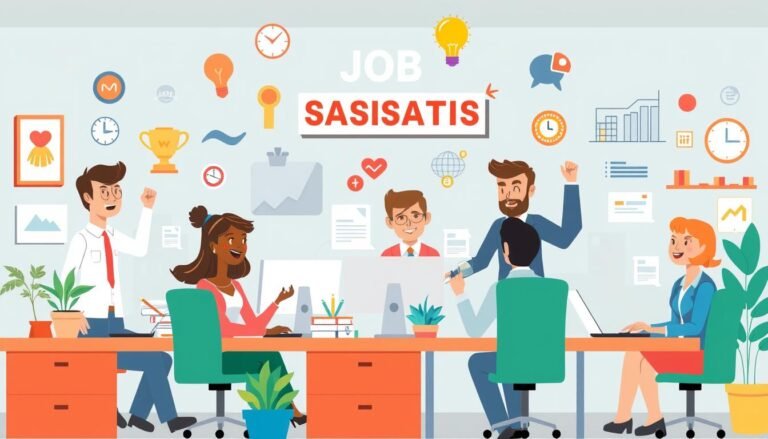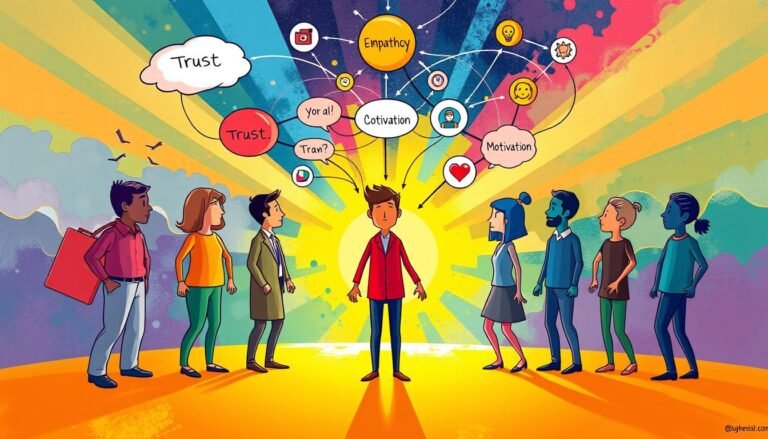Master Conflict Management in the Workplace with These Psychological Tips
Ever wondered why some workplaces do well while others struggle with disputes? The key often lies in how they handle conflicts. Workplace disputes are common, but with the right strategies, they can help everyone grow.
Conflict management is key in today’s diverse workplaces. American businesses lose $359 billion each year due to unresolved conflicts. This shows that solving disputes is crucial for success.
Knowing the psychology behind workplace disputes can be your advantage. By using specific psychological techniques, you can turn harmful situations into useful talks. This method not only fixes problems but also builds a culture of respect and open communication.
Key Takeaways
- Effective conflict management is essential for workplace productivity
- Psychological techniques can transform disputes into opportunities
- Poor communication is a leading cause of workplace conflicts
- Emotional intelligence plays a crucial role in resolving disputes
- Active listening and assertive communication are vital conflict resolution skills
- Unresolved conflicts can lead to significant financial losses for businesses
Understanding the Nature of Workplace Conflicts
Workplace conflicts are common in any job setting. They can be small disagreements or big fights, affecting how well we work together. Knowing why and how these conflicts happen is key to a peaceful work place.
Common Causes of Conflict in the Workplace
There are many reasons for workplace conflicts. Poor communication is a big one, causing misunderstandings and anger. When roles and responsibilities are unclear, it can lead to tension. Different ways of working and personalities can also cause problems.
- Miscommunication or lack of effective communication
- Unclear expectations and roles
- Differing work styles and personalities
- Perceptions of unequal contribution or workload imbalances
- Stressful work environments
Impact of Unresolved Conflicts on Productivity
Unresolved conflicts can really hurt how well we work. They can make us less productive, lead to more people missing work, and cause more people to leave. In some cases, conflicts can cut productivity by up to 30%.
Companies that don’t deal with conflicts may spend more on hiring, training, and legal issues.
| Conflict Impact | Percentage |
|---|---|
| Productivity Reduction | Up to 30% |
| Increased Job Satisfaction with Resolution | Over 50% |
| Conflicts Resolved through Mediation | Approximately 80% |
Recognizing Early Signs of Conflict
Spotting conflicts early is important for quick action. Look for changes in how people talk, more tension in meetings, or less teamwork. Regular talks and surveys can help find where conflicts are common, helping plan how to fix them.
By understanding workplace conflicts, companies can find ways to manage and solve them. This helps create a better, more productive work place for everyone.
The Importance of Effective Communication in Conflict Resolution
Effective communication is key in solving conflicts. It helps us understand and fix disagreements at work. Good communication skills stop misunderstandings and make the workplace better.
Professor Abdul Ghaffar from Qurtuba University sees conflicts as positive. He believes they bring up important issues, energize work, and show our differences. This shows we need good communication to use these benefits.
Strategies for solving conflicts often use communication skills. Techniques like role-playing, tracking conflicts, and teaching good listening can help. These methods help employees manage conflicts well.
“Effective communication is not just about speaking clearly, but also about listening actively and responding empathetically.”
The Crisis Prevention Institute has tips for de-escalating conflicts that focus on communication:
- Show empathy
- Respect personal space
- Focus on feelings
These tips show how communication can calm tense situations and solve problems. By improving communication, employees can handle workplace conflicts better. This makes the work environment more peaceful.
| Communication Skill | Impact on Conflict Resolution |
|---|---|
| Active Listening | Creates safe space for open dialogue |
| Empathy | Builds understanding between parties |
| Clear Expression | Reduces misunderstandings |
| Timing | Ensures receptiveness to discussion |
By getting better at these communication skills, people can solve conflicts more effectively. This leads to better work relationships and more productivity.
Developing Emotional Intelligence for Better Conflict Management
Emotional intelligence is key in managing workplace conflicts. It was developed by psychologists Peter Salovey and John D. Mayer. This skill set changes how we deal with disputes.
Self-awareness and Self-regulation
Self-awareness is the base of emotional intelligence. It lets us know our feelings during conflicts, stopping us from acting on impulse. Self-regulation keeps us calm in stressful times, leading to better talks.
Empathy and Social Skills
Empathy lets us see things from others’ viewpoints, building trust and lowering tensions. Social skills help us talk well, share our thoughts, and listen well. These are key for finding solutions that work for everyone.
Applying Emotional Intelligence in Tense Situations
In stressful times, emotional intelligence really shows. It helps spot what causes conflicts, calm things down, and help mediate. People with high emotional intelligence are seen as trustworthy and fair. This makes a workplace where everyone works together better.
“Emotional intelligence significantly enhances communication skills vital in conflict resolution, reducing misunderstandings and building trust.”
Improving emotional intelligence takes time and effort. Self-reflection, listening well, and being mindful help grow these skills. By improving our emotional intelligence, we can turn workplace conflicts into chances for growth and teamwork.
Key Conflict Resolution Skills for Workplace Leaders
Workplace leaders must have strong conflict resolution skills to create a positive work environment. These skills help solve disagreements before they get worse. Let’s look at the key abilities that can turn challenges into growth opportunities.
Effective leadership in conflict management includes active listening, empathy, and clear communication. Leaders who excel in these areas can greatly improve team dynamics and productivity. A survey by Randstad found that 34% of employees would leave their jobs due to a toxic work environment. This shows how crucial these skills are.
Negotiation and problem-solving are essential for workplace leaders. By using a structured approach to conflict resolution, leaders can help their teams find constructive solutions. This involves identifying the issue, brainstorming solutions, evaluating options, and choosing the best action.
| Skill | Impact on Workplace |
|---|---|
| Active Listening | Improves understanding and reduces misunderstandings |
| Emotional Intelligence | Enhances team awareness and self-regulation |
| Impartiality | Ensures fair resolution and builds trust |
| Patience | Allows for thoughtful solutions and reduces tension |
Leaders with these conflict management skills lead to better teamwork and job satisfaction. By mastering these abilities, leaders can turn unhappy team members into engaged contributors. This creates a culture of open communication and mutual respect.
Conflict Management Strategies: The Thomas-Kilmann Model
The Thomas-Kilmann model gives us great insights into managing conflicts. It was created in 1974. It shows five ways to deal with workplace disputes, based on how assertive and cooperative you are.
Avoiding
This method uses low assertiveness and cooperation. It’s good for small issues or when emotions are high. Those who use it often avoid conflicts or delay talking about them.
Competing
This style has high assertiveness and low cooperation. It works well for quick decisions or unpopular actions. People using this way push their views strongly.
Accommodating
This strategy has low assertiveness but high cooperation. It’s best when keeping relationships is more important than winning. Those who use it give in to others to keep peace.
Compromising
This method balances assertiveness and cooperation. It tries to satisfy everyone a little. It’s good for when time is short or when both sides are strong.
Collaborating
This approach is high in both assertiveness and cooperation. It looks for solutions where everyone wins. It’s perfect for complex problems where creative solutions are needed.
Knowing these strategies can help leaders find the best ways to solve conflicts. The goal is to pick the right approach for each situation to get the best results.
Mediation Techniques for HR Professionals
HR professionals are key in managing workplace conflicts. They use mediation techniques to solve disputes and keep the work environment peaceful. Research shows that 85% of conflicts can be fixed quickly and well.
Active listening is a crucial skill for HR professionals. Those who listen well can solve 80% of conflicts. They hear both sides, find the real issues, and help parties find common ground.
Empathy and emotional intelligence are also vital. When HR professionals show these, 65% of conflicts are solved for good. They understand the feelings and reasons behind each side’s actions, helping solve problems better.
Clear communication is essential in solving conflicts. When HR professionals communicate clearly, 95% of conflicts have positive results. They explain what’s expected, clear up any confusion, and help parties talk productively.
“The art of mediation lies in fostering understanding and guiding parties toward mutually beneficial solutions.”
Negotiation skills are also important for HR professionals. With good negotiation, 70% of conflicts are solved. They find creative solutions that work for everyone involved.
By using these techniques, HR professionals can greatly improve how conflicts are handled at work. With training and practice, they can make the workplace better for everyone.
Creating a Positive Work Culture to Minimize Conflicts
A positive work culture is essential for preventing conflicts and improving teamwork. It creates an environment of respect and open communication. This helps reduce tensions and boosts productivity.
Promoting Respect and Collaboration
Respect is the base of a peaceful workplace. Companies that celebrate diversity see a 20% boost in employee morale and engagement. Diverse teams are 35% more likely to outperform others, showing the value of inclusivity.
Implementing Effective Communication Policies
Clear communication policies are key to preventing conflicts. They can cut misunderstandings that cause conflicts by 50%. Having formal ways to solve conflicts can make employees 20% happier and more likely to stay.
Encouraging Team-Building Activities
Team-building activities are crucial for a positive work culture. They increase teamwork and unity by 30%. Mentoring programs can reduce conflicts by 15% and solve problems in 70% of cases.
| Initiative | Impact |
|---|---|
| Diversity Celebration | 20% increase in employee morale |
| Effective Communication | 50% reduction in conflict-causing misunderstandings |
| Team-Building Activities | 30% increase in collaboration and unity |
| Mentoring Programs | 15% reduction in conflicts |
By focusing on these areas, companies can build a positive work culture. This culture minimizes conflicts and boosts team performance and employee happiness.
Problem-Solving Approaches in Conflict Resolution
Problem-solving in conflict resolution leads to more agreements and win-win outcomes. Companies with fair and cohesive cultures often use these methods. Let’s look at some effective ways to solve workplace conflicts.
- Identifying the problem
- Generating alternative strategies
- Selecting and implementing a solution
- Evaluating consequences
The Plan Do Check Act (PDCA) approach is a well-known method. It has four steps:
- Plan: Define the problem and potential solutions
- Do: Implement the chosen solution on a small scale
- Check: Evaluate the results
- Act: Apply the solution widely if successful, or start over if not
The “5 Whys” method is another effective way to solve conflicts. It involves asking “why” five times to find the root cause. This way, you can tackle the real issues causing the conflict.
“Conflict can be an opportunity for growth in relationships or work.” – Adam Grant, The Wharton School
When solving conflicts, focus on interests and needs, not just positions. This helps find solutions everyone can agree on, leading to better results.
| Problem-Solving Technique | Key Benefit |
|---|---|
| PDCA Approach | Systematic problem-solving |
| 5 Whys Method | Identifies root causes |
| Interest-Based Approach | Promotes win-win solutions |
The Role of Active Listening in Conflict Management
Active listening is key in managing conflicts. It helps us understand each other better and solve problems at work. By listening actively, we can talk better and strengthen our relationships.
Techniques for Improving Active Listening Skills
To get better at listening, try these tips:
- Give your full attention to the speaker
- Maintain eye contact
- Ask open-ended questions
- Summarize key points
- Pay attention to non-verbal cues
Benefits of Active Listening in Conflict Resolution
Active listening has many benefits in solving conflicts:
| Benefit | Impact |
|---|---|
| Reduced misunderstandings | 80% of workplace conflicts arise from poor communication |
| Increased resolution efficiency | 50% of conflicts resolve faster with active listening |
| Improved mutual satisfaction | 60% higher chance of reaching agreeable solutions |
| Enhanced trust | Perceived as more empathetic by peers |
Practicing Empathy Through Active Listening
Empathy is crucial in managing conflicts. By listening actively, we show respect for others’ views. This makes people less defensive and helps solve problems better. Remember, 70% of successful conflict resolutions come from active listening.
Mastering active listening helps us handle workplace conflicts better. It’s a vital skill that promotes understanding, trust, and positive outcomes for all.
Conclusion
Learning how to manage conflicts is key to a peaceful workplace. Over 8,000 companies have used EasyLlama for this training. They focus on emotional smarts and understanding different cultures.
This training helps teams work well together, even in tough situations. It teaches them to handle conflicts directly.
Preventing conflicts starts with giving employees and managers the right tools. Talking openly and making decisions clearly helps avoid mistakes. Listening well is also crucial, making everyone understand each other better.
Good conflict management brings positive changes. It uses methods like talking things out, mediation, and arbitration. The aim is to find a fair solution for everyone.
By solving the real issues, we stop conflicts from happening again. This way, our workplaces keep getting better.
Conflict management is a never-ending journey. With the right training and tools, we can turn conflicts into chances for growth. This approach not only solves problems but also makes our teams stronger and more ready for the future.
Source Links
- Five Conflict-Resolution Strategies for the Workplace
- 5 Strategies for Conflict Resolution in the Workplace
- 14 Conflict Resolution Strategies for the Workplace
- Understanding and Managing Conflict in the Workplace
- Managing Workplace Conflict
- 6 Conflict Management Strategies for a Harmonious Workplace
- Effective Communication Is Key To Resolving Conflicts
- What Type of Communication during Conflict is Beneficial for Intimate Relationships?
- The Power of Effective Communication in Conflict Resolution
- How Emotional Intelligence Impacts Conflict Resolution
- The Role of Emotional Intelligence in Conflict Resolution: How to Manage Conflicts Effectively in the Corporate World?
- The Relationship Between Emotional Intelligence and Conflict Management Strategies From the Nurse Managers’ Perspective
- Being a leader in any organization is no easy task. Not only are leaders responsible for their actions, and the ramifications thereof, they are also responsible for the behavior and actions of their team members. Running a team like a well-oiled machine is no easy task, as more often than not it
- 7 Successful Conflict Management Skills Every Leader Needs to Know
- What is the Thomas Kilmann Conflict Management Model? (With examples)
- What’s Your Conflict Management Style? | Walden University
- Employee Mediation Techniques – Resolve Disputes and Manage Conflict with These Mediation Skills
- HR 101 | Conflict Resolution Strategies for the Workplace
- Conflict Resolution and Mediation Skills for HR Professionals – HR Partners | Human Resources Outsourcing
- Strategies for Conflict Resolution in a Diverse Workplace — Loeb Leadership
- Leveraging Conflict Management To Maintain A Positive Work Environment
- How workplace culture can reduce conflict and stress
- Summary of "Problem Solving and Decision Making in Conflict Resolution"
- Conflict Resolution and Problem Solving
- 12 principles of a problem solving approach to conflict resolution
- Use active listening skills to effectively deal with conflict
- The Importance of Listening in Conflict Resolution – MediationWorksFL
- What is Active Listening? Definition, Skills, and Examples – Pollack Peacebuilding Systems
- Conclusion to Conflict Resolution And Management | Easy Llama Training
- Evaluate conflict management in society







